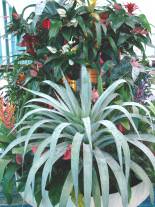|
In the wild, every plant lives outdoors
Houseplants are those we enjoy which also will endure typical conditions in homes and other buildings people use
Successful indoor plants are shade tolerant (grow in low light in the wild) and are specially 'shade grown' by commercial growers who offer indoor plants. Being shade grown means the nursery will grow the plants outdoors here in Florida, but use a shade cloth overhead, blocking 50-70% of the sun's power
Many times plants are first grown in full sun or partial shade then, after some months, moved to be under under shade cloth. Nurseries do this to promote maximum growth then 'convert' plants to shade grown specimens in the last few months before sale
When you see houseplants at a garden center, they have been growing in top quality professional grower conditions. You take them home, place in your indoor location, then very often your plant declines, very quickly, here is why
Full blooded 'true tropicals' are plants that typically can not stand any cold weather whatsoever. For example, the Red Sealing Wax Palm is perfectly happy in full sun, but throws a fit if the temperature drops below about 55 degrees. Such true tropicals may or may not be used as houseplants
Caution:
You will see plants such as the Areca palms sold as houseplants, but they do poorly indoors because they demand humidity. Majesty palm is another example of what is sold as an indoor plant that can be difficult indoors but stabilizes after initial decline
Some plants such as bromeliads may or may not bloom indoors. Indoor conditions vary from home to home so those providing conditions close to sub-tropical you also enjoy blooms, better leaf size and color, larger growth, etc.
Houseplants all want the same conditions:
- Bright light but not necessarily any direct sun. Morning sun is always acceptable if it's not a hot exposure. Bright light for 5 hours a day (or more)
- Humidity, 70 percent or more would be very nice
- Warmth, over 75 degrees at all times. No sudden cold or drafts
- Pure water, rain water being by far the best. If possible, create a rain collection system so you will always have some on hand for your plants. A large bucket to collect rain off the roof is fine
- Good soil. This would be a 'pro mix' or a 'nursery mix' that is based on Canadian peat moss, then added wood chips, charcoal, Perlite, or, instead of Perlite, about 30-40% coarse sand. Tropical plants DO NOT want (heavy) 'top soil'
- Fast and easy drainage. Water should pour through your soil and out the bottom very easily. Trays, saucers, at the bottom of indoor pots = murder, if trays hold "old" water over time because water becomes putrid and can rot roots from the bottom up
- Good food. See our article
- Clean leaves. More information here
- Pest free. See our article
- Very few need or want misting. But some tropicals like occassional misting, especially to overcome low indoor humidity
If you approximate these conditions in your home, you will have successful houseplants of almost any variety
If you can not provide enough sun/light/hours, that's trouble so you may want to buy a professional GRO light
If you have less accommodating conditions, you can still grow many houseplants. You'll just need to be happy with the tougher plant types. Master Gardener will always classify houseplants we offer for sale so you know if your home can be hospitable to any variety you wish to grow
|
- Lucky Bamboo, Dracaena sanderiana, article
- ZZ Plant, Zamioculcas zamiifolia, article
- Ti Plant, Cordyline terminalis, article
- Alocasia, article
- Begonia, article
- Peace Lily, Spathiphyllum spp., article
- Calathea, article
- Bromeliads, article
- Anthurium, article
- Bridal Veil Vine, Stephanotis floribunda, article
- Swiss Cheese vine, Monstera deliciosa, article
- Spider Plant, Chlorophytum capense, article
- Lady palm, Rhapis excelsa, article
- Caladiums are also called 'elephant ears', article
- China Doll, Radermachera sinica, article
- Money Tree, Pachira aquatica, article
- Spider Plant, Chlorophytum capense, article
- Umbrella tree, Umbrella plant, Schefflera actinophylla, article
- Arborcola, Schefflera arborcola, article
- White Bird-of-Paradise, Strelitzia nicolai, article
- Buddha's Hand, Citrus medica var. sarcodactylus, Pic #1 #2 #3 #4 #5 #6
- Rubber tree, Ficus elastica, Pic #1 #2 #3 #4 #5 #6
- Fiddle Leaf Fig tree, Ficus lyrata, pic
- Ficus benjamina, Pic #1 #2
- Ficus teneke, pic
- Ficus Alii, pic
- Kentia palm, Sentry Palm, Howea forsteriana, pic
- Parlor palm, Chamaedorea elegans, pic
- Fishtail palm, Caryota mities, Pic #1 #2
- Dracaena marginata, pic
- Dracaena 'Lemon Lime', pic
- Dracaena compacta 'Janet Craig' Pics #1 #2
- Cast Iron Plant, Aspidistra elatior, pic
- Mother-in-Law Tongue, Snake Plant, Sanseveria spp., Pic #1 #2
- Watermelon peperomia, Peperomia argyreia, pic
- Corn Plant, Dracaena fragrans, Pic #1 #2
- Pothos vine, Epipremnum pinntum, Pic #1 #2
- Ivy 'Pittsburgh', Pic #1 #2 #3
- Syngonium spp. (vine), pic
- Wandering Jew, Tradescantia zebrina, pic
- Yucca plant, Yucca aloifolia, Pic #1 #2
- Ming aralia, pic
- Jade plant, Crassula argentea, Pic #1 #2
- Dieffenbachia spp., Pic #1 #2
- Philodendron, Philodendron squamiferum, Pic
#1 #2
- Fittonia 'Red Star', Fittonia argyroneura, pic
- Gerbera Daisy, Gerbera jamesonii, Pic #1 #2
#3 #4
- Gloriosa Lily 'Crimson Flame', Pic #1 #2
|

